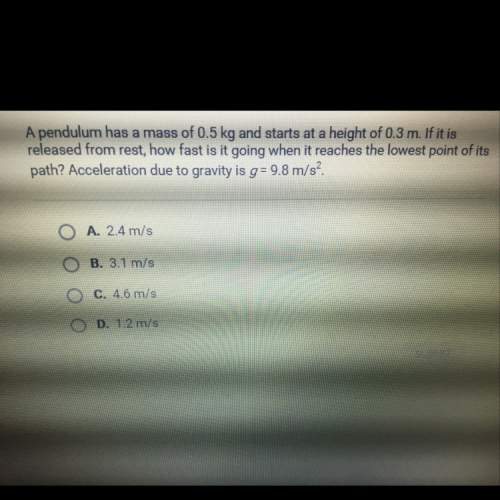
Physics, 24.03.2020 20:15 eman123adama
Please help
1.) Describe the processes of fuel ignition and combustion.
2.) List the requirements of a practical fuel.
3.) Number the statements listed below in the order that they would occur in engine operation. Then, label these stages as intake, compression, power, or exhaust.
a. The fuel mixture is ignited by the spark plug, and the resulting explosion forces the piston down in the cylinder.
b. The piston rises and compresses the fuel mixture in the combustion chamber.
c. The exhaust gases left over from the combustion are released from the cylinder.
d. A mixture of air and fuel is drawn into the cylinder.
4.) Identify the part or item associated with the internal-combustion engine that the statement is describing. Choose from the following parts: cylinder, engine block, piston, cylinder head, combustion chamber, intake valve, exhaust valve, spark plug, stroke, and crankshaft.
a. The metal cover that seals the top of the cylinder
b. The valve that allows burned gases (waste products) to vent out of the cylinder
c. A solid metal into which the cylinder is drilled
d. The total distance that the piston moves from the top of the cylinder to the bottom
e. A can-shaped component that can move smoothly up and down inside the cylinder
f. The valve that allows the air-and-fuel mixture to be delivered to the cylinder
g. A hollow metal tube drilled into the solid metal engine block
h. The open area located above the piston, positioned at the very top of the cylinder (This is where the air and gasoline mix and burn to produce power.)
i. Piece connected to the piston by a connecting rod (With the rod, this part converts the up-and-down motion of the piston to rotary motion, which makes the car move forward.
j. Part screwed into a hole in the cylinder head and used to make sparks that will ignite the air-and-fuel mixture in the cylinder and cause it to burn.
5.) Compare and contrast turbojet and rocket engines.
6.) List the types of fuels suitable for rocket engines.

Answers: 3


Another question on Physics

Physics, 22.06.2019 04:30
Light from the sun reaches the earth in 8.3 minutes. the velocity is 3.00 x 10^8 m/s. how far is earth from the sun? i know how to get to d = (3 x 10^8 m/s)(498 sec). i just don't know how to get from there to the answer being 1.5 x 10^11 m.
Answers: 3

Physics, 22.06.2019 16:00
While the change in blank will remain the same during a collision, the force needed to bring an object to a stop can be blank if the time if collision is blank
Answers: 1

Physics, 22.06.2019 20:10
Atruck with 34-in.-diameter wheels is traveling at 55 mi/h. find the angular speed of the wheels in rad/min, *hint convert miles to inches & hours to minutes:
Answers: 2

Physics, 23.06.2019 01:40
(8%) problem 12. a bowling ball of mass mb 3 kg 's rolled down the lane with a velocity ofy-2/ m s lt strikes a single remaining pin mp 0.93 kg head on. after the collision the bowling ball has a velocity (in the same direction) of v2 1.1 m/s. = ▲ 33% part (a) write an expression for the velocity of pin in the horizontal direction after the impact, im ,, 33% part (b) what is the pins speed in ms? 33% part (c) assuming the coefficient of friction s μ,-0.1. how far in meters could the pin slide before stopping if it doesn't topple?
Answers: 1
You know the right answer?
Please help
1.) Describe the processes of fuel ignition and combustion.
2.) List t...
1.) Describe the processes of fuel ignition and combustion.
2.) List t...
Questions



Mathematics, 21.05.2021 14:00

Mathematics, 21.05.2021 14:00

Mathematics, 21.05.2021 14:00




English, 21.05.2021 14:00

Mathematics, 21.05.2021 14:00

Chemistry, 21.05.2021 14:00

Mathematics, 21.05.2021 14:00

Mathematics, 21.05.2021 14:00

History, 21.05.2021 14:00



Mathematics, 21.05.2021 14:00


Mathematics, 21.05.2021 14:00

Mathematics, 21.05.2021 14:00




